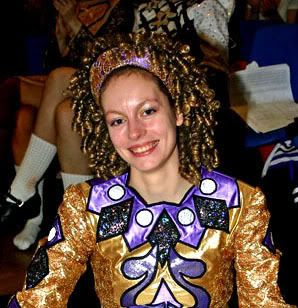Metallic embroidery thread is a bit of a different beast than the normal embroidery threads. First of all, it is made of completely different fibers and second of all, the structure and thickness differ. All of this makes the behavior of metallics a bit frustrating when dealing with it in your sewing machine.
The biggest problem when trying to do a nice satin stitch in this kind of thread is the breakage. It just seems to want to break *all* the time....
Metallic threads are thinner and less sturdy. Therefore, any snag or tension problem in the thread will cause it to break easily.

The inherent problem is that metallic tread has a slight stiffness and twist that make it very easy for the thread to supertwist
(twist upon itself) and cause problems between the tension discs or thread guides on the sewing machine. Unlike normal thread, it insists upon going it's own way and needs a slight tension from the spool to the machine and the tensions discs to be guided properly and behave itself. If it is rolling off the spool too loosely, it will start curling wildly around every loop and hook. Complex super-twisted knots will form in seconds, your needle stalls or pulls up all the bobbin threads like a birds nest and then the machine comes to a halt. If you are lucky the threads snap and you can just pull out your work and clean it up. If unlucky, your needle might break and you have to open up the bobbin house to clean up the tangled mess.
Sounds familiar?
The key to working under these circumstances is tension and twist control. If the spool is put horizontally when unravelling the thread, supertwisting in much less likely to occur. Some sewing machines already have a horizontal spool holder, but they can only carry small spools. For those of us that use the bigger spools or do not have the horizontal holder, you will have to find an alternative way of feeding the thread.
Many sewists lay the spool down in a box and just let it roll in there. This is usually a very good way of dealing with the problem and works for small and medium sized spools.
I use a very big spool myself, and putting it in a box like that causes too much friction when the spool turns to unravel. Thus the tension in the thread becomes too high and I start pulling up the bobbin again. Also, because the rolling occurs in little "shocks" instead of a steady roll, the tension becomes too uneven and this causes problems in the stitching as well, like gaps and missed stitches -not to mention the dreaded supertwisting.
I heard some people hang their spools in all sorts of contraptions to get the desired tension-effect and eliminate the supertwisting. Some even have the thread span from across half their sewing room before it is fed into the machine :-). Some people also make a board with horizontal pins that can function as spool holders.
To

solve my problem I hung mine on a cotton thread above my machine. The spool unravelled perfectly with very few twisting problems. The only thing I needed to be careful of was to hang it in a slight angle from the sewing machine. Otherwise the thread would work itself off the spool and would get tangled on the cotton thread. I guess a simple spacer or disc added at the top of the spool would take care of that easily, but this worked as well. Elegant is perhaps not the correct term for it, but if it works...it works!






 My name is Caroline Vermeulen. I started to make irish dance dresses some years ago when a friend asked me for help with embroidering her dress. Today, I run a small dressmaking business called Lowland Design. I make custom costumes and ready-to-wear dresses. This blog is dedicated to show my work to others. I hope you enjoy.
My name is Caroline Vermeulen. I started to make irish dance dresses some years ago when a friend asked me for help with embroidering her dress. Today, I run a small dressmaking business called Lowland Design. I make custom costumes and ready-to-wear dresses. This blog is dedicated to show my work to others. I hope you enjoy.




